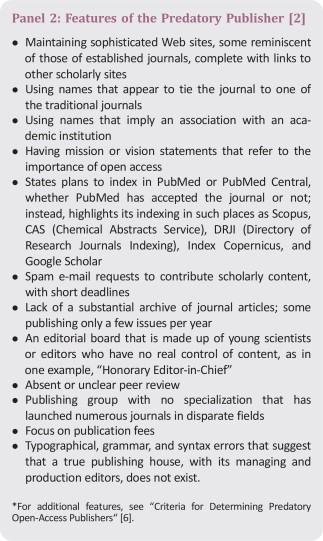-
PDF
- Split View
-
Views
-
Cite
Cite
Susan E. Bates, Too Many Journals, The Oncologist, Volume 22, Issue 2, February 2017, Pages 126–128, https://doi.org/10.1634/theoncologist.2017-0012
Close - Share Icon Share
2016 was a year in which the political arena captured social media—transforming America’s 250‐year‐old electoral process. This was but one more event in the evolution of our digital age, affecting all walks of society. In medicine, the digital era has brought us big data and unprecedented access to knowledge. For example, the cBioPortal for Cancer Genomics houses publicly available genomic data sets on samples from more than 26,000 patients. We have the electronic medical record with the potential for infinite data collection and endless privacy breaches. But arguably, the greatest impact has been in medical publishing. The medical literature was for centuries the chief communication tool among researchers and physicians, with the oldest known medical text originating in Egypt and dating to 1800 BC.
The “modern” era of peer‐reviewed publishing began some 200 years ago (Panel 1), evolving into an ecosystem in which investigators submit their work to peer review, revise, resubmit, and pay page charges after acceptance. In turn, libraries purchase journal subscriptions for their readers. In recent years, library journal subscription fees have climbed, forcing libraries to trim their offerings. Individual article download fees are now commonplace, often ranging from $30–$50 for a single article. Investigators seek publication in the most highly respected, high‐impact factor journals, considered the sine qua non for academic success. For some publishers, the result has been a bounty and, for others, a thin margin in which to stay in business.

This ecosystem has been upended in recent years—propelled by policies promoting open access, which began as a worthy initiative to provide the public with unrestricted, free access to scholarly research. As the Budapest Open Access Initiative states [1], “An old tradition and a new technology have converged to make possible an unprecedented public good.” This document, arising from a 2001 meeting on open access, preceded the Berlin and Bethesda statements, which followed in 2003 to further define open access. Several types of open access evolved: green (author’s accepted manuscript is deposited into an open‐access repository for free access after 6 or 12 months); gold (author publishes in an open‐access journal, paying publication fees upfront); hybrid (authors have the option of paying for open access in a subscription journal); and platinum (open‐access publication costs are borne by funding mechanisms other than author publication fees). Unanticipated was the avalanche of gold open‐access journals that would emerge.
Open access is obviously important: lives depend on medical progress, and progress is often based on synthesizing what has gone before. But for those in biomedical research, professional issues have also emerged. Although some argue that publication in high‐impact journals—such as The New England Journal of Medicine, The Lancet, Nature, and Science—is needed for jobs and for promotions, most argue that those “high‐impact factor” journals favor well‐known or well‐funded investigators and that publishing there is increasingly difficult. The impact factor reflects the average number of citations to recent articles published in a particular journal, pushing journals to reduce the number of pages published and in turn the number of articles accepted in an attempt to raise the impact factor. These forces work against most investigators.
Open access offered an increase in accessibility and an ease in publication of data that, coupled with advances in the ease of online website delivery, rapidly led to the uptake of online‐only open access journals, many of these launched as “sister journals” to traditional mainline journals. If it ended there, this would be a good story. But a startling increase in the number of gold open access publishing groups resulted—not only the sister journals but new publishing groups with large slates of journals. The term “predatory” has been applied to many of these gold open‐access publishing groups; these publishers often simultaneously launch numerous, disparate journal titles. Features of these journals appear in a report by Clemons et al. [2] and are summarized in Panel 2. Librarian Jeffrey Beall promulgated “Beall’s List of Predatory Open‐Access Publishers,” which called out these publishing groups and journals. Beall found 18 predatory publishers in 2011, 225 in 2013, 693 in 2015, and 1,155 in 2017. [3]

In this issue of The Oncologist, Clemons et al. bring to our attention the problem of predatory invitations from journals [2]. One oncologist, over the course of 3 months, received 191 invitations to publish in open‐access journals. Most of the journals and/or publishers were on Beall’s list of possible or probable predatory publishers. Clemons et al. note common features of these invitations, including the invitation being unrelated to oncology (n = 125, 65.4%), use of hyperbole around the recipient’s academic reputation (n = 92, 48.2%), a claim to be open access (n = 92, 48.2%), and a promise of peer review (n = 65, 34.0%). Clemons et al. also point out that logos and journal names can be quite similar to established journals. These are flags that should alert investigators to the true nature of the invitation.
As Clemons et al. note, the danger of accepting the invitation is publishing in a journal that has few or no other articles, is not peer‐reviewed, is not indexed and therefore not searchable or findable, and is susceptible to being discontinued if not sufficiently profitable. He points out that the “publish or perish” mentality of biomedicine and the high rejection rates of established journals can make these offers tempting. Awareness needs to be raised in the academic community to avoid these invitations.
Clemons et al. also point out that Beall’s list is curated by a single individual. And a number of journals have found themselves on the list despite a long track record of academic publishing. The Frontiers series is on the list of predatory publishers—and does have a diverse array of journal titles. But it was founded as Frontiers in Neuroscience in 2007 by two neuroscientists from the Swiss Federal Institute of Technology in Lausanne, Switzerland, has published more than 2,400 papers, and has an impact factor of 3.398. Frontiers in Pharmacology has published more than 1,600 papers since 2010 and has an impact factor of 4.418. Frontiers in Oncology has 1,560 online papers and a respected editorial board and field chief editor but doesn’t have an impact factor as yet. The journal websites have a very different look and feel, as if imagining a new vision in publishing. Hard to argue these are not academic journals. Given that the number on Beall’s list for 2017 exceeds 1,000, even a 5% error rate could entrap and mislabel a significant number of academic journals and, by extension, those who publish therein.
Thus, we have a maelstrom arising from gold open‐access publishing. At one end of the continuum are publishing groups in name only, perhaps a single computer or desk somewhere in the world, without any biomedical history or interest, launching more than 90 journals at a time—journals that are poorly peer reviewed, are not indexed, and may not be around for more than a year. At the other end of the continuum are the established journals with high impact factors, in which it is more difficult to publish. A recent study showed that the likelihood of a postdoctoral fellow having a first author paper in Cell, Science, or Nature had dropped dramatically in recent years, just as figure size and panel number increased, meaning postdoctoral fellows contribute sweat and blood to such papers but do not reap the rewards [4].
An ironic twist in all of this, and a likely validation of the profitability of the gold open‐access scenario, is seen in the launch of numerous “sister” or specialty journals carrying the traditional high‐impact factor journal brand. These are often online‐only journals. Blood Advances was just launched in December 2016. The Lancet and JAMA each have 12 branded specialty journals. Nature journals have the largest number: 27 journals identify as a Nature subspecialty and 18 are branded Nature Reviews. These journals often leap to high impact factors within the first year of launch, competing for publishing space with the traditional “subspecialty journal.” Indeed, among the almost 150 journals at the Nature website [5] are many of these newfound competitors.
So here we are. Too many journals. This is not sustainable and cannot be the future—and I think it particularly affects young researchers. There has been a marked increase in the number of invitations to submit papers—the subject of the article in this issue of The Oncologist. For many of these submissions, the peer review process may be marginal, decreasing the quality of science and scholarship. Research may be lost forever when published in a journal that was discontinued because it wasn’t profitable enough. With a marked increase in the number of papers on any given topic, especially invited review articles (sought for their ability to raise impact factors), it has become difficult to find original research or older discoveries. With this, there will inevitably be duplication of research effort. The invited reviews go well beyond the number needed for scholarly thought and dissemination of results. Multiple review articles on the same topic compete for readership, dilute effort, and do not advance the field. The flood of papers is such that investigators writing their next paper will simply turn to the most recent Nature or JAMA papers for citation, raising the Nature or JAMA impact factor while decreasing the visibility of any young investigator who published in a lower impact factor journal. It is not clear what the future should be, but this is not it. It is time for a new Budapest Initiative to think collectively about directions for biomedical publishing.
Disclosures
The author indicated no financial relationships.
For Further Reading: Peter Andrew,Michael M.Vickers, Stephen O’Connor et al.Media Reporting of Practice‐Changing Clinical Trials in Oncology: A North American Perspective. The Oncologist 2016; 21:269–278.
Implications for Practice: North American newspapers, cable news, cancer websites, and industry websites were searched for their reporting on 17 practicechanging clinical trials in oncology as highlighted by the American Society of Clinical Oncology in its 2012 annual report, Clinical Cancer Advances. Accuracy of reporting across media platforms was evaluated, and the social media buzz and academic interest generated by each clinical trial was gauged. The findings represent, to the authors’ knowledge, the first systematic effort to appraise the reporting of practice‐changing clinical trials in oncology across various media platforms. Use of a standardized reporting template by the media is proposed to reduce flaws in their reporting of clinical trials to the public.
References
Author notes
Disclosures of potential conflicts of interest may be found at the end of this article.
Editor’s Note: Jeffrey Beall’s list of “Predatory Open‐Access Publishers” referenced in [3] above is no longer available online. See the related article, “Predatory Invitations from Journals:More Than Just a Nuisance?” by Mark Clemons et al. on page https://doi.org/10.1634/theoncologist.2016-0371236 of this issue.



